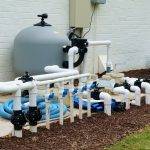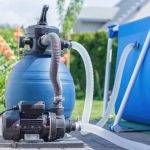There are three basic types of pool filters, all in widespread use – Sand, DE (diatomaceous earth) and Cartridge. Each type has its pros and cons, but when used properly, any of the three will do an excellent job of keeping your pool clear and free of all but the smallest particles.
Sand Filters
• Filters particles down to 30 microns, largest of the three types
• Simple to backwash when pressure rises 25% above the clean pressure
• Uses the most water to backwash
• Deep clean filter once a year
DE Filters
• Filters particles down to 3 microns, smallest of the three types
• Requires backwashing to clean grids when pressure rises 25% above the clean pressure
• Have to recharge filter with DE after each backwash and/or tear down
• Might be required to have a DE separation tank to capture the DE when backwashing
• Complete tear down once a year to clean grids
Cartridge Filters
• Filters particles down to 10 microns, middle of the three types
• No backwashing required, saves water
• Must tear down filter to clean cartridges each time when pressure rises 25% above the clean pressure
• Cartridges need replacing every few years
Before we get into the details of the individual types, let’s spend a minute looking at what they have in common. All three filter types are used in series with your main pool pump, allowing the water to pass through the filter media before re-entering the pool. The media traps dust, dirt, oils, hair, and other small particles and removes them from water column. As a general rule of thumb, it is a good idea to oversize your filter. A larger filter will ensure you have adequate surface area and will also allow you longer periods of time between cleaning.
First we’ll look at Sand Filters. Some say sand is the easiest to maintain but its filtering ability is the lowest – down to about 30 microns. This can be particularly evident if your pool is lighted at night. Filter aids such as DE powder or cellulose fiber, however, can help improve sand’s filtering ability. Cleaning a sand filter is easy, when the pressure reaches 25% above the clean pressure, backwash the filter to remove the trapped dirt and debris. Backwashing is about a 10 minute process. The constant backwashing will tend to throw your water balance off but this can be useful if you use trichlor or cal hypo. Sand does occasionally need a more thorough cleaning than backwashing alone can do. Once a year open up the filter and insert a garden hose in the sand to let the water flush out all the crud that has collected in the sand until the overflow is clean. You might have to CAREFULLY break up the sand with something like a broom handle if it is clumped together, CAREFULLY so you don’t damage the laterals. If there is evidence of scale buildup on the sand, then an acidic sand cleaner might be needed to clean the sand of the scale.
The next, and most effective filter media, is DE (diatomaceous earth). DE is made up of fossilized diatoms (porous, sponge like microscopic organism) and can filter down into the 3-5 micron range. If you do a lot of night swimming in a lighted pool you might want to invest in one since this is where the difference in water clarity really can show up. There are 2 basic kinds of DE filters the bump and the backwash. The theory behind the bump type is that when the filter gets dirty, 25% above the clean pressure, you ‘bump’ the dirty DE off the grids so it can mix with the dirt and then re-coat the grids with dirty DE. If the pressure does not reduce, then the filter should be torn down and cleaned. The other type is the backwash type and when the filter pressure rises 25% above the clean pressure you need to flush the DE and dirt out of the filter by backwashing. After each backwashing you will need to replace about 50% of the total DE. Be aware that some townships require a DE separation tank for back-washing DE filters. This can add to both the expense and the space they take up on your equipment pad.
Finally we have Cartridge filters. There is no backwashing involved so your water balance tends to stay put (a plus with a SWG, a minus if you use trichlor). Their filtering ability approaches DE in particle size filtered out (as low as 10 microns.) Cartridges do wear out and need to be replaced every few years. For very big pools they are not practical since you will be stuck with one of those 4 cartridge monsters that are a real pain to clean. However, some townships have outlawed sand and DE filters so in those areas, cartridges are the only choice. Proper cleaning is not hard but it can be a bit messy. Wear your swimsuit so if you get a bit wet it’s no big deal. Cleaning is about a half hour process. You have to remove the lid, pull out the cartridges and wash them individually between the pleats, using a pressure tip water hose.





